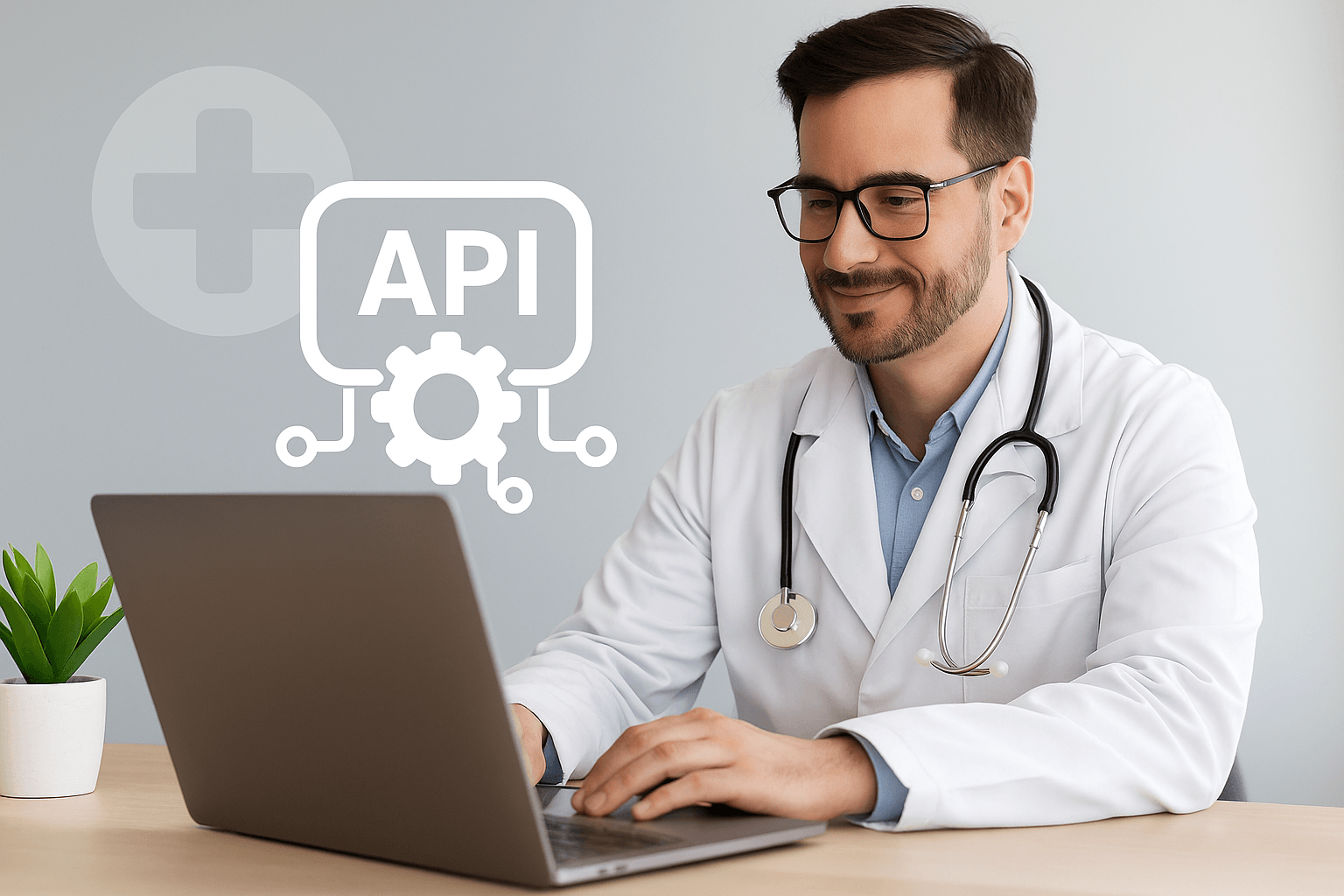Building a modern healthcare application requires more than clean code and sleek design. You need it to be able to connect with EHRs, sync with wearables, support video calls, and handle sensitive data, all without missing a beat.
That’s where APIs for healthcare come in.
Think of APIs as the nervous system of your HealthTech product. They let your app communicate with electronic health records, pull in real-time vitals from wearables, enable video consultations, or even automate insurance eligibility checks.
Put simply, they let your app talk to the rest of the healthcare system (and help you stay compliant with tough privacy laws).
So if you're building something in 2025, a telehealth app, a remote monitoring tool, or a patient portal, you’ll need the right APIs to make it work.
In this blog post, we’ll walk you through some of the most reliable and developer-friendly healthcare APIs available today.
What to Look for in a Healthcare API?
Not all healthcare APIs are created equal. Some are built for large enterprise systems. Others are more nimble, perfect for fast-moving startups. Either way, if you're going to build something solid, you need to pick the right tools.
Here are a few things to keep in mind when evaluating APIs for healthcare:
- Regulatory Compliance: Make sure it’s built to meet HIPAA, GDPR, and any other privacy rules that apply to your users.
- EHR and FHIR Support: If your app connects to electronic health records, you’ll want support for HL7, FHIR, or both. These are the languages the big systems speak.
- Real-Time Data Exchange: Syncing vitals from a wearable or processing a video consult, speed and reliability are crucial. Look for APIs that can handle real-time updates without choking.
- Developer Experience: Good documentation, clean SDKs, sandbox environments, all of that makes a big difference. You don’t want to fight the API every time you want to build something new.
- Scalability: As your user base grows, your API should keep up. Rate limits, uptime SLAs, and support tiers are worth checking.
- Pricing and Flexibility: Transparent pricing, usage-based models, and options for startups or trials can save you headaches down the road.
Pick an API that fits your existing stack, meets your privacy needs, and won’t hold you back when it’s time to scale.
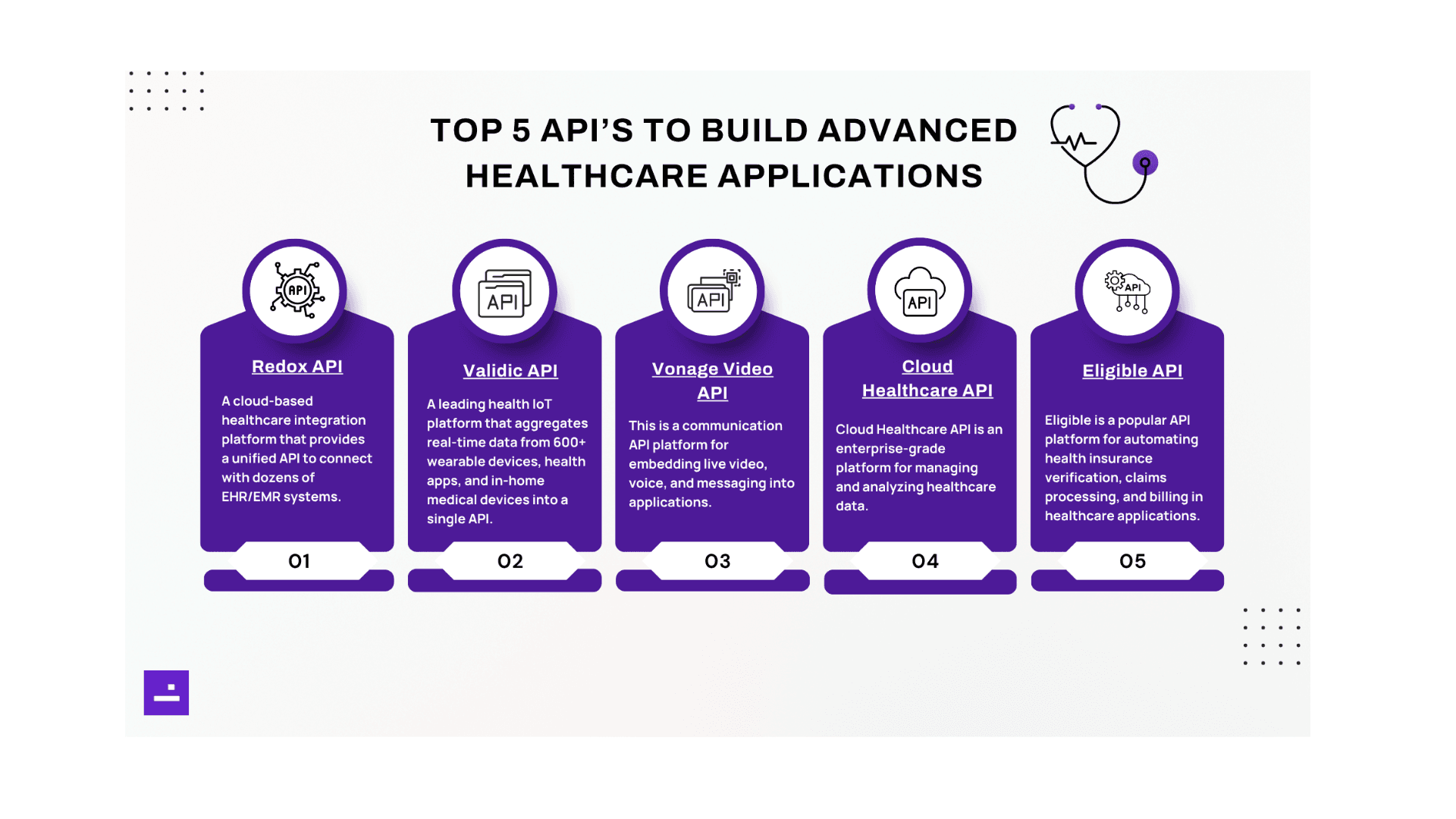
Top 5 Healthcare APIs You Should Know About
There’s no shortage of APIs for healthcare out there. However, some stand out because they’re easy to work with, built for healthcare, and trusted by serious product teams.
Here’s a handpicked list across key categories like EHR integration, telehealth, and insurance.
1. Redox API: EHR/EMR Integration
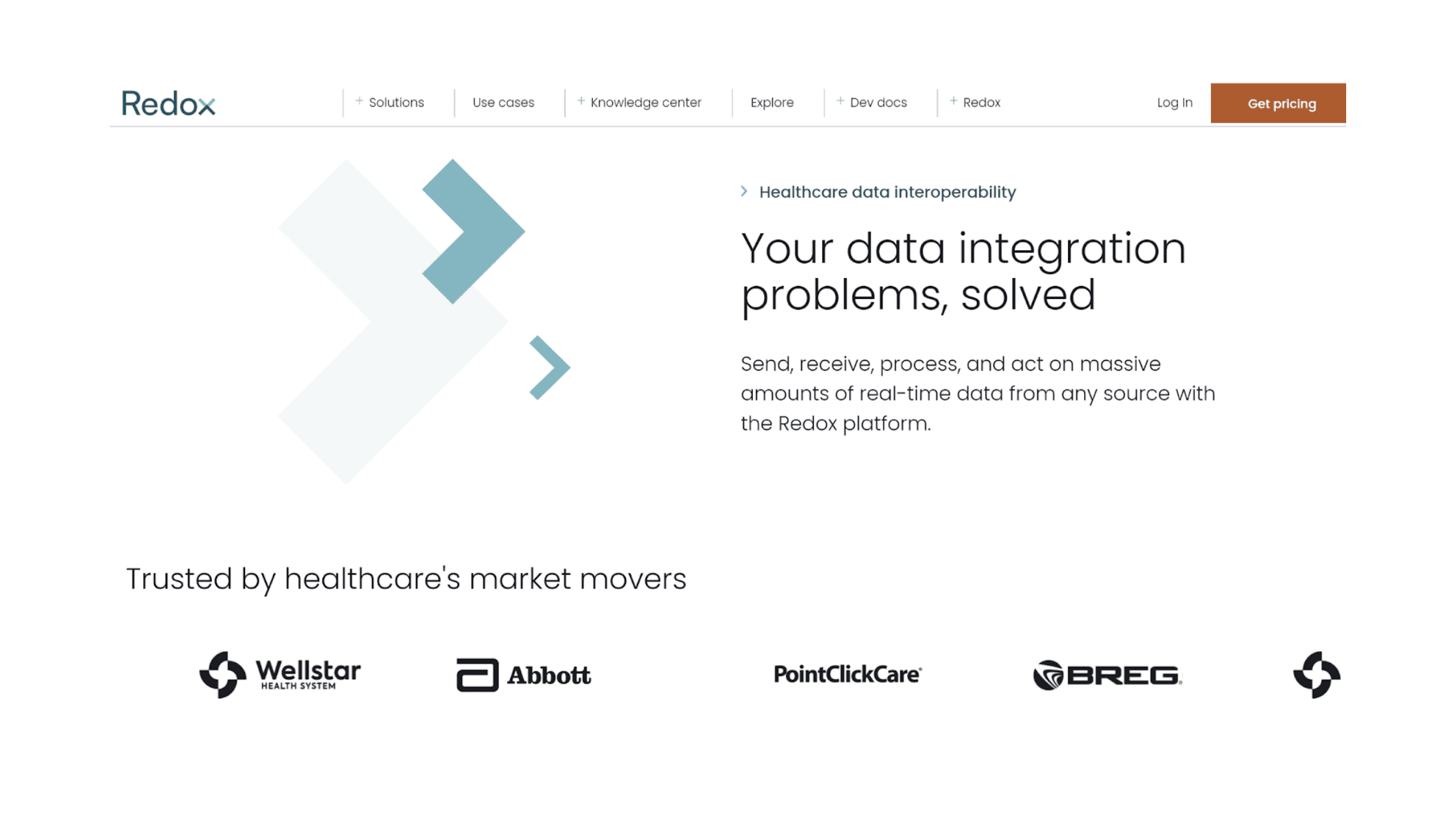
Redox is a cloud-based healthcare integration platform that provides a unified API to connect with dozens of EHR/EMR systems (e.g. Epic, Cerner, Allscripts). It normalizes data across HL7v2, FHIR, and legacy formats, enabling apps to send/receive patient records, clinical data, scheduling info, and more through one endpoint. Redox handles the heavy lifting of interoperability, including secure data transmission and compliance.
Use Cases: Digital health startups and enterprises use Redox to integrate their applications with hospital EHRs and practice management systems. Example use cases include pulling patient demographics and clinical history from an EMR, pushing telehealth encounter notes back into the EHR, syncing appointment schedules, or querying medication/allergy lists in real time.
Redox allows new applications (patient portals, care coordination tools, etc.) to work seamlessly with existing healthcare IT systems.
Supported Platforms: As a RESTful web API, you can use Redox from any platform (web backends, cloud functions, mobile apps via backend). Redox provides SDKs and supports secure data exchange over HTTPS. It’s language-agnostic, so developers can call the API from their server or cloud environment of choice.
Pricing: Redox typically charges a platform access fee and per-connection or per-transaction fees. For example, one report cites a ~$45,000 platform access fee plus ~$7K to $12K per EHR connection, with a newer usage model of about $0.08 per API call.
A free trial is available to test integration before scaling up. Pricing is custom-quoted based on the number of integrations and transaction volume.
Region Support & Compliance: Redox primarily operates in the U.S. market (with connectivity to major U.S. hospital systems), and it adheres to HIPAA regulations for PHI. It offers a Business Associate Agreement (BAA) for HIPAA compliance.
Redox can integrate with standards (HL7, FHIR) used internationally, but its network of ready-made EHR connections is US-focused. Security certifications like SOC 2 are in place. For EU projects, direct FHIR server solutions or regional interoperability networks may be more common, though the Redox API itself is agnostic to region if the endpoints are accessible.
Documentation: Redox developer docs, API reference, and the Redox website are available for technical and business details.
2. Validic API: Wearables & Medical Device Data
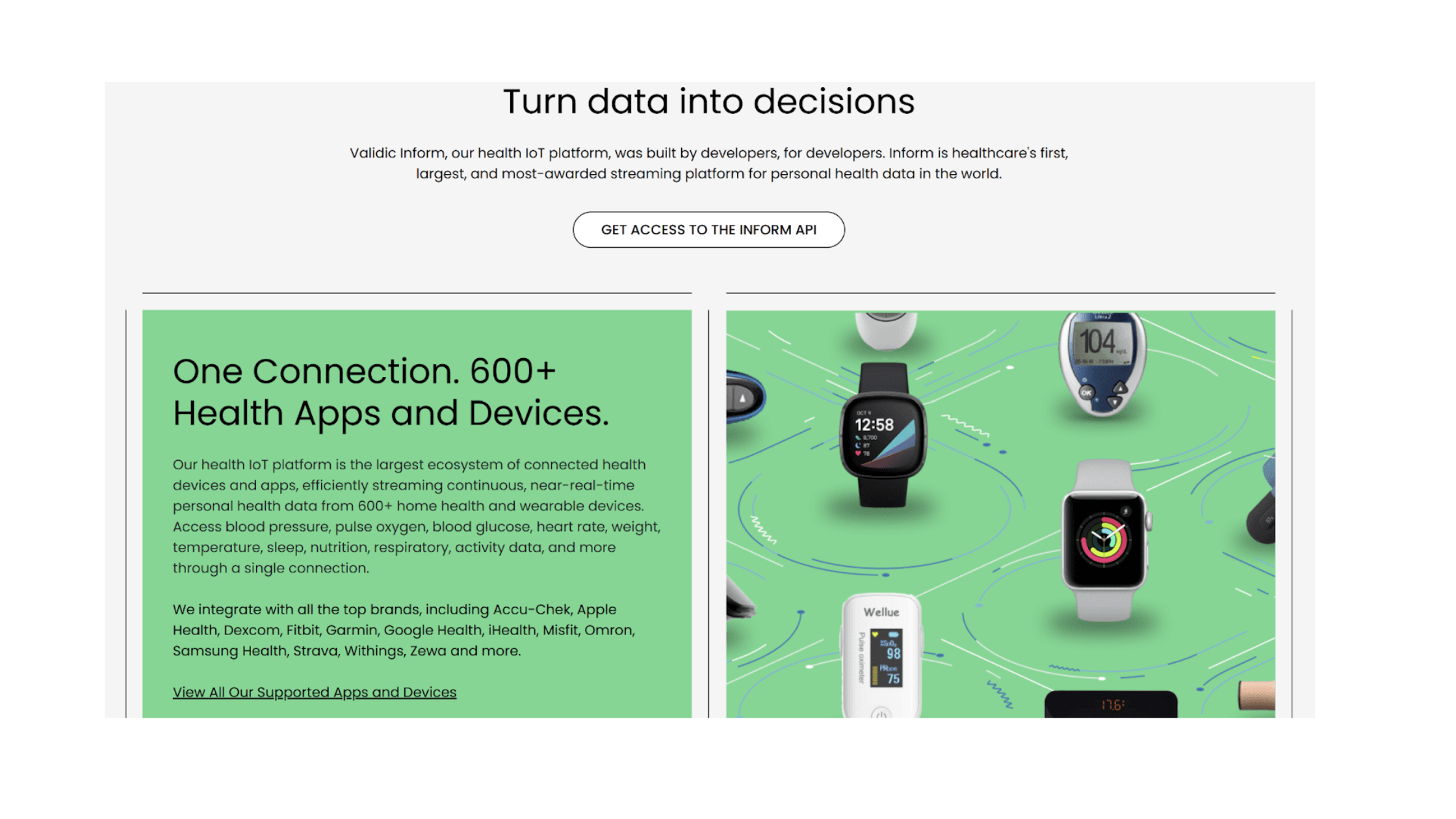
Validic is a leading health IoT platform that aggregates real-time data from 600+ wearable devices, health apps, and in-home medical devices into a single API. It streams near real-time personal health data, such as blood pressure, heart rate, blood glucose, oxygen saturation, weight, sleep, activity, and more, from popular brands (Apple Health, Fitbit, Garmin, Dexcom, Withings, etc.).
Validic normalizes this data into a consistent format and provides a secure, HIPAA-compliant pipeline for integrating device-generated data into healthcare systems.
Use Cases: Ideal for remote patient monitoring, chronic disease management, and wellness programs. For example, a telehealth platform can use Validic to pull a diabetic patient’s daily glucose readings from their glucometer, or a hospital can integrate patients’ fitness tracker steps, heart rate, and sleep data into the EHR for clinicians to view. It enables population health apps to monitor patient vitals remotely and triggers alerts for out-of-range readings.
Supported Platforms: Validic is provided as a RESTful API, so developers can integrate it into web or mobile app backends. It also offers SDKs for ease of connecting user-authorized accounts. You can pull data into cloud applications or on-premise systems.
It supports high-frequency data streaming (e.g., per-minute readings for certain metrics). The platform handles the many third-party device APIs on the backend, so developers interact only with Validic’s unified API.
Pricing: Validic is a commercial platform aimed at healthcare organizations. Pricing is based on usage (number of data sources, number of users/devices, data frequency) and typically involves an enterprise subscription. There is no public free tier for production use, and interested organizations must contact Validic for a quote.
Region Support & Compliance: Validic’s platform is HIPAA-compliant and built for clinical use. They manage regulatory compliance, data security, and maintain integrations (including handling each device maker’s terms and updates).
You can use Validic in the US (HIPAA) and internationally. In Europe, GDPR compliance is achievable since Validic acts as a data processor with robust security. Healthcare organizations would need to ensure proper data agreements.
Documentation: Official technical docs and API reference are available via the Validic Developer Portal, and product information is on the Validic Website. These resources detail the data models, supported devices, and integration guides.
3. Vonage Video API: Telemedicine & Video Consultations

The Vonage Video API (formerly TokBox OpenTok) is a communication API platform for embedding live video, voice, and messaging into applications. It provides feature-rich video conferencing capabilities tailored to telehealth needs, including multi-party video calls, one-to-one consults, screen sharing, text chat, call recording, and end-to-end encryption options. The API supports WebRTC under the hood for high-quality, low-latency streams.
Use Cases: Developers commonly use it to integrate video visits and virtual care workflows into telehealth apps. For example, a clinic’s patient portal can use Vonage to power one-click video consultations between patients and doctors (in-browser or in-app). It works well for mental health counseling apps with group therapy video sessions, for adding family members or interpreters into a medical video call, and for remote specialist consultations (e.g., a primary doctor invites a specialist via video).
The Vonage Video API (formerly TokBox OpenTok) is a communication API platform for embedding live video, voice, and messaging into applications. It provides feature-rich video conferencing capabilities tailored to telehealth needs, including multi-party video calls, one-to-one consults, screen sharing, text chat, call recording, and end-to-end encryption options. The API supports WebRTC under the hood for high-quality, low-latency streams.
Use Cases: Developers commonly use it to integrate video visits and virtual care workflows into telehealth apps. For example, a clinic’s patient portal can use Vonage to power one-click video consultations between patients and doctors (in-browser or in-app). It works well for mental health counseling apps with group therapy video sessions, for adding family members or interpreters into a medical video call, and for remote specialist consultations (e.g., a primary doctor invites a specialist via video).
The API’s fine-grained controls and features (like dynamic layout, muting, screen share for tele-presentations of lab results or imaging, etc.) make it suitable for building custom telemedicine experiences. Many telehealth providers count on Vonage/TokBox due to its reliability and healthcare focus (Vonage reports serving millions of telehealth sessions worldwide).
Supported Platforms: Vonage provides client SDKs for web (JavaScript), iOS, Android, and desktop, allowing integration on virtually any platform. Developers can embed video streams into web apps or create native mobile telehealth apps. The API scales from peer-to-peer calls to large group sessions.
It also supports PSTN phone dial-in if needed. Because it’s a cloud API, participants can join from different platforms seamlessly. Global infrastructure ensures stable connections in North America, Europe, Asia, etc.
Pricing: Vonage Video API uses a pay-as-you-go pricing model based on participant minutes. Rates are roughly in line with industry norms (on the order of $0.004 per participant per minute for live video). For example, a 1:1 video call for 10 minutes counts as 2 participants * 10 min = 20 participant-minutes (~$0.08). Volume discounts apply at higher usage. Vonage offers a free trial with some free minutes included (e.g., ~2,000 minutes/mo for initial plans).
Region Support & Compliance: Vonage’s communications platform is globally available with data centers in the US, Europe, and Asia. For healthcare, HIPAA compliance is supported. Vonage will sign a BAA with customers and provide the necessary security (encryption, access controls) to satisfy HIPAA requirements. The API has robust security features (encrypted media streams, optional end-to-end encryption, and GDPR-compliant practices).
Documentation: Developers can refer to the Vonage Video API Docs for guidance and the official Vonage Video API product page for an overview of features and compliance. These resources include quickstart tutorials, SDK references, and best practices for secure telehealth implementations.
4. Google Cloud Healthcare API: Medical Data & Imaging Analysis
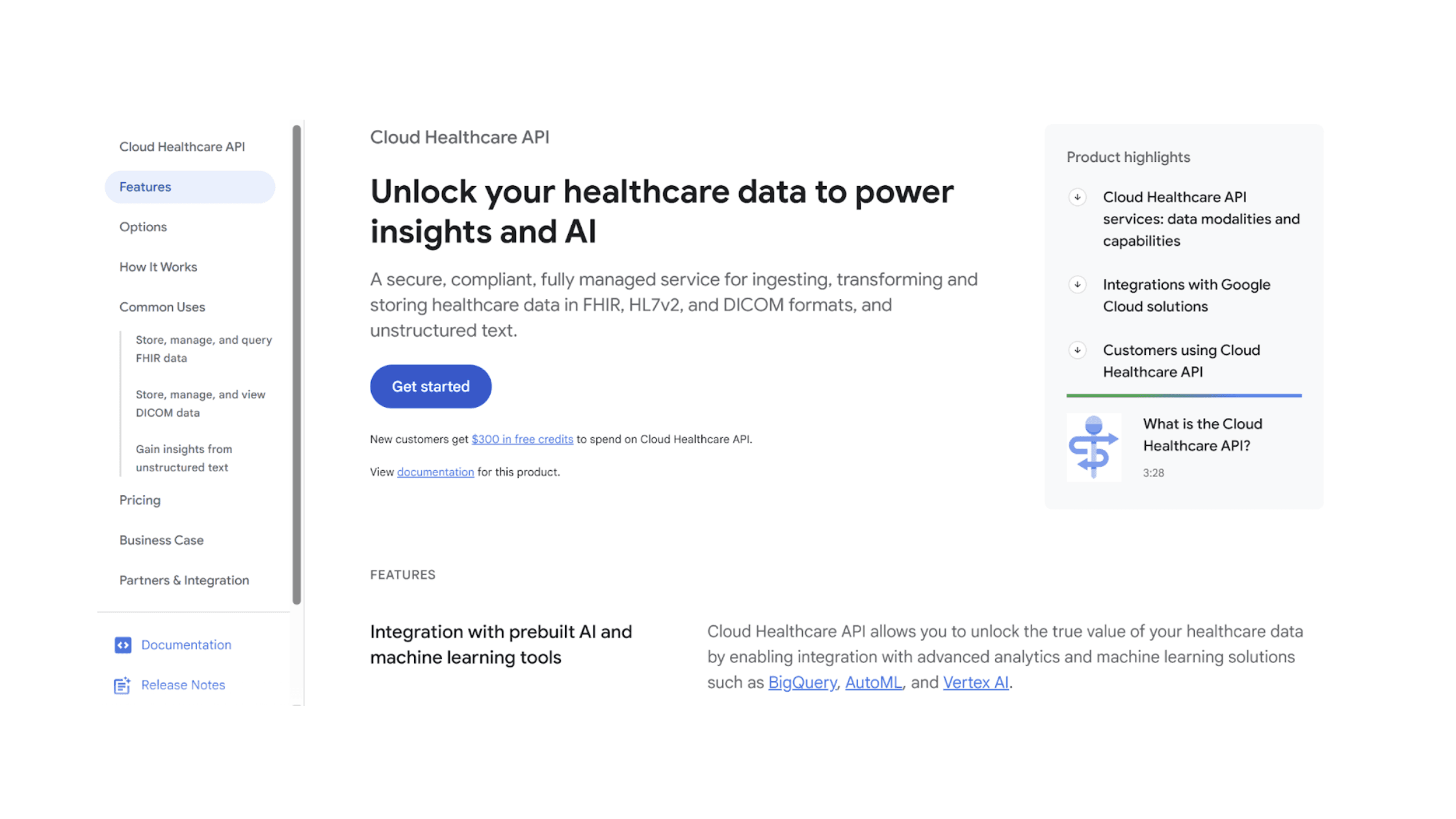
Google Cloud Healthcare API is an enterprise-grade platform for managing and analyzing healthcare data. It offers fully managed storage and exchange of data in standard healthcare formats: notably FHIR or EHR data, HL7v2 messages, and DICOM for medical imaging.
Use Cases: This API enables secure data ingestion from various sources (EHR systems, labs, devices), data transformation, and integration with Google’s analytics and AI tools. For medical imaging, the platform supports DICOMweb APIs, allowing applications to store, query, and retrieve imaging studies (X-rays, MRIs, CT scans, etc.) in the cloud, and even apply machine learning on them.
Google’s healthcare API also includes de-identification tools for removing PHI, and it integrates with BigQuery and AI Platform for running advanced analytics or AI diagnostics on the data.
Population health or research platforms use it to combine datasets (EHR, genomic, imaging) for big data analysis. Essentially, it provides the “plumbing” to build anything from telehealth systems with integrated records to AI diagnostic services, with Google’s scalability and compliance.
Supported Platforms: The Healthcare API is a cloud service (part of Google Cloud Platform), accessible via REST and gRPC APIs. Google provides client libraries (Java, Python, etc.) to simplify integration. Developers can use it in backend services, data pipelines, or even directly from client apps if properly authorized. The API can handle mobile or web app data by acting as the secure store (for example, a mobile cardiology app could send ECG readings to the FHIR store via the API).
Pricing: Google Cloud Healthcare API pricing is based on resources used, data storage (per GB per month for FHIR stores, DICOM stores, etc.), data access operations, and any associated cloud infrastructure usage.
There is no flat license fee. Instead, you pay for what you use. Google offers a pricing calculator and free tier credits. For instance, storing 100GB of FHIR data or a number of DICOM images will have a cost per month, plus charges per API call (read/write) beyond free quotas.
Region Support & Compliance: Google Cloud supports deployments in multiple regions (US, EU, Asia, etc.), allowing data to be stored in specific regions to meet data residency rules. The Healthcare API is HIPAA-compliant (Google will sign a BAA for Google Cloud services) and adheres to healthcare standards (it natively supports HL7, FHIR, HL7v2, DICOM standards).
It also meets stringent security certifications (Google notes compliance with ISO/IEC 27001, 27017, 27018, etc.). For GDPR, customers can choose EU data centers and have full control over data access and deletion, using Google’s GDPR compliance offerings.
Documentation: Official documentation is provided on Google Cloud’s site: Google Cloud Healthcare API Docs and the product page, which includes explanations of features (like FHIR, DICOM storage, de-identification). Google also has solution guides for using the Healthcare API in common scenarios (e.g., building a clinical data repository, connecting wearables, etc.).
5. Eligible API: Insurance Claims & Eligibility
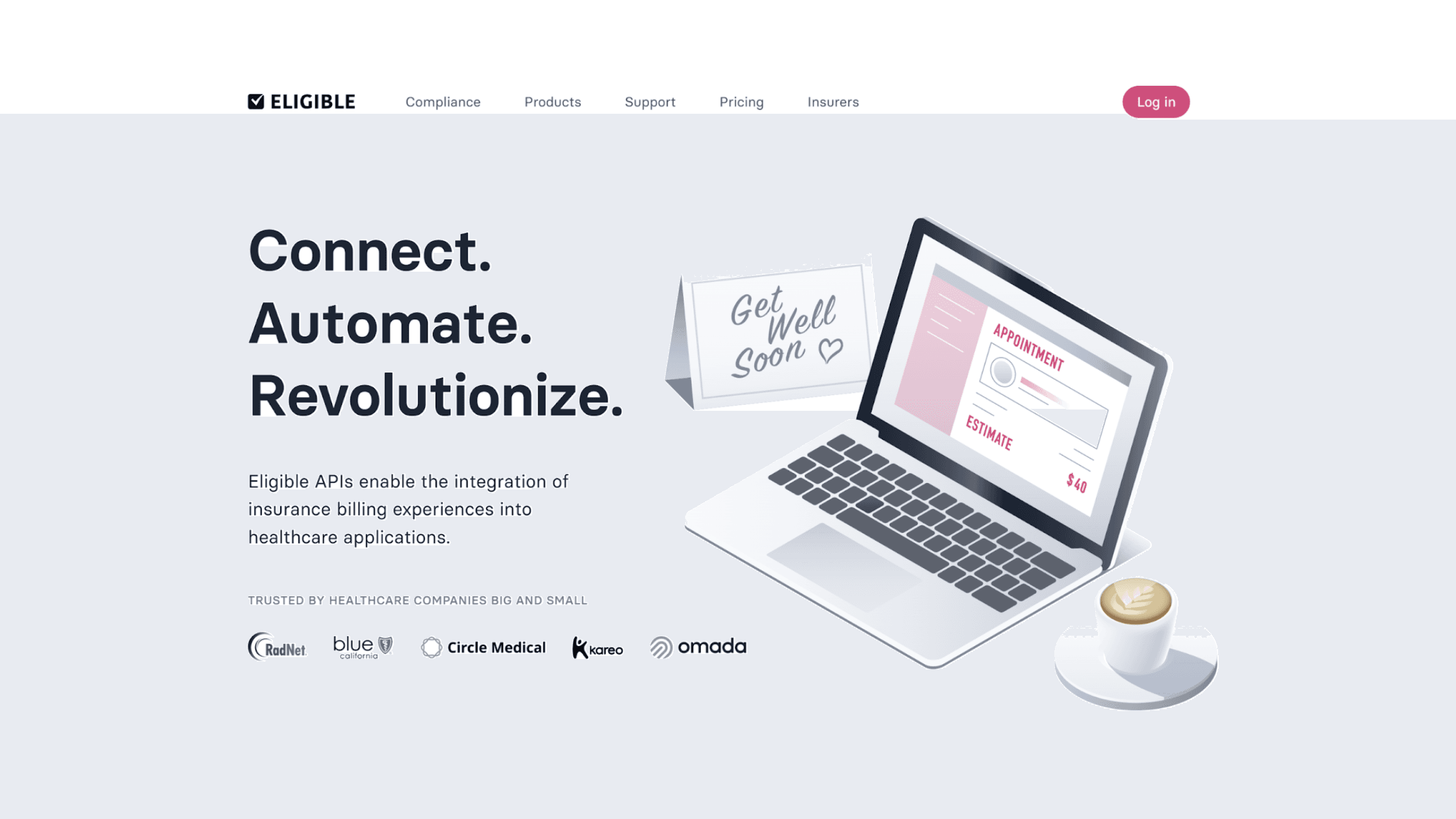
Eligible is a popular API platform for automating health insurance verification, claims processing, and billing in healthcare applications. It connects with hundreds of insurance payers to provide real-time insurance eligibility checks, benefit coverage details, claims submission, claims status tracking, and cost estimation.
Use Cases: This API is useful for practice management systems, appointment scheduling apps, telehealth platforms, and medical billing software to streamline financial clearance and billing. Eligibility checking is a prime use: when a patient registers or books an appointment, an app can call Eligible to confirm their insurance is active and see covered services, eliminating manual checks.
For example, with a simple API call, you can verify a patient’s insurance plan coverage and co-pay amounts for a procedure, or submit an electronic claim and get the adjudication status. Eligible abstracts the complex payer networks into a developer-friendly REST API. After a telehealth visit, the provider’s app can submit the claim via Eligible and later query claim status, automating the revenue cycle. Some apps use it to compute patient out-of-pocket costs by querying the patient’s benefits (for transparency before providing a service).
Supported Platforms: Eligible is available as a web service (RESTful API with JSON responses). Any platform capable of making HTTPS requests can use it (web backends, mobile app backends, or even serverless functions). Typically, it will be your server (or a secure client) making calls to Eligible, since it involves sensitive financial data. They also have client libraries (in languages like Python, Ruby, etc.) to simplify integration.
The API can handle high volumes securely, suitable for both small apps and large health systems. There’s also a sandbox for testing with dummy data.
Pricing: Eligible’s pricing model includes transaction fees for each call (with some free transactions possibly included in a monthly minimum). For instance, eligibility inquiries might be around $0.05 per transaction, and cost estimation queries around $0.25 each. High-volume customers (like large clinics or billing companies) might negotiate custom pricing.
Region Support & Compliance: Eligible’s services are focused on the United States insurance system. It connects to U.S. insurance payers and supports transactions like HIPAA X12 270/271 (eligibility) and 837/835 (claims/billing) under the hood. It is HIPAA-compliant—as a vendor handling PHI (patient insurance info, etc.), Eligible will sign BAAs and has appropriate security measures.
Documentation: Official docs can be found on the Eligible API Reference (developer documentation for eligibility and claims endpoints).
How SoluteLabs Can Help You Build With the Right APIs?
APIs are the glue holding modern healthcare apps together. From syncing patient records to enabling video consults, they power the features your users expect.
The ones we’ve covered here are a great starting point. Working on a remote monitoring app, telehealth platform, or an innovative new solution, these APIs accelerate your development process.
Want a partner who can help you build healthcare software that’s reliable, secure, and future-ready? Let’s talk.
